#thus the offshoot
Text
< king of being confusing at the most random ass moments lol
#I have. puppet who is a clown named after the song that inspired him#and then I have. unnamed robot thing made from nightmarionne fnaf which is an offshoot from puppet fnaf#and the clown came first so I’d feel weird renaming him lol#what’s worse is!!! they’re planned to interact and it’s the only thing I’ve ACTUALLY got planned for those two thus far lol
1 note
·
View note
Text

See, this is what I’m talking about with hyperbolic & totalizing rhetoric both obscuring the actual problems and inevitably falling back on antisemitic libel.
At no point have I said the destruction or loss of life in any war isn’t excessive. But when war isn’t enough for you to criticize it, and it has to be “genocide” for you to care, you become more susceptible to filling the holes with hyperbole and misinformation. And more often than not, the hyperbole & conspiracy theories that are closest in reach rely on antisemitic tropes.
It isn’t enough that bombs are inherently destructive to human life & infrastructure, and that even “precision bombs” are not actually that precise; it has to be the worst, most total version of that thing—it has to be “carpet bombing”.
It isn’t enough to criticize the concept of civilian casualties as acceptable “collateral damage” in war; Israel has to be especially evil, so they have to be intentionally targeting civilians for the sake of it—thus the long and well-documented history of Hamas using civilians as “human shields” (even openly literally bragging about it), preventing civilians from escaping, and building military bases under civilian infrastructure, as well as the status quo of accepting civilian casualties in warfare, both remain unaddressed.
It isn’t enough that the destruction of war causes food and water scarcity, it has to be intentionally engineered. It has to be Israel poisoning wells.
And there it is: well-poisoning, an antisemitic libel nearly as old as—one could argue, an offshoot of—blood libel.
The claim that Israel is poisoning Palestinian wells is so baseless that even the source of that claim, Mahmoud Abbas, admitted his accusations were entirely baseless the very next day:

I’m pointing out that specific claim because it’s the easiest to illustrate just how baseless & bigoted it is. But it goes deeper than that: the same totalizing rhetoric and thought process that led this person to believe that antisemitic lie is also responsible for their willingness to attribute Hamas blocking escape routes to the IDF, to describe the bombing of military targets under civilian infrastructure as ”carpet bombing”, and that Israel is trying to exterminate the Palestinian people, despite so much evidence to the contrary.
I am not downplaying the loss of life & tragedy of this conflict or “mincing words” when I say this; I am not even denying the possibility that at some point more information may surface that suggests extermination was actually Netanyahu’s goal (though we are not there).
I am pointing out how this totalizing rhetoric, and the eagerness to believe Israelis are evil, genocidal monsters is impeding the left’s ability to accurately assess & address the root causes of that loss of life. I am pointing out how this goes deeper than just avoiding a checklist of antisemitic tropes. I am asking you to ask yourself, “What is making me so susceptible to believing Jews would poison wells or commit genocide?” “What bad habits am I engaging in with regard to my thought processes & rhetorical habits that makes me more prone to believing this?“
568 notes
·
View notes
Text
Updated vaccines against Covid-19 are coming, just as hospitalizations and deaths due to the virus are steadily ticking up again.
Today, the US Food and Drug Administration authorized new mRNA booster shots from Moderna and Pfizer, and a panel of outside experts that advises the Centers for Disease Control and Prevention voted to recommend the shots to everyone in the United States ages 6 months and older. Once Centers for Disease Control and Prevention director Mandy Cohen signs off on the recommendations and the vaccines are shipped, people can start getting the boosters.
The recommendation is projected to prevent about 400,000 hospitalizations and 40,000 deaths over the next two years, according to data presented at the meeting by CDC epidemiologist Megan Wallace.
This year’s mRNA vaccines are different from the 2022 booster in a key way. Last year’s shot was a bivalent vaccine, meaning it covered two variants: the original one that emerged in China in 2019, plus the Omicron subvariant BA.5, which was circulating during much of 2022. This fall’s booster drops the original variant, which is no longer circulating and is unlikely to return. It targets just the Omicron subvariant XBB.1.5, which was dominant throughout much of 2023.
Pfizer and Moderna’s vaccines work by introducing a tiny piece of genetic material called messenger RNA, or mRNA, that carries instructions for making SARS-CoV-2’s characteristic spike protein. Once it is injected, cells in the body use those instructions to temporarily make the spike protein. The immune system recognizes the protein as foreign and generates antibodies against it. Those antibodies stick around so that if they encounter that foreign invader again, they will mount a response against it.
Since the start of the Covid-19 pandemic, the virus has acquired new mutations in its spike protein and elsewhere. These mutations result in new variants and subvariants that diverge from the original virus. When enough mutations accumulate, these new versions can more easily evade the antibodies created by previous vaccine doses or infections.
The constantly evolving nature of the virus is the reason health regulators decided last year to update the original mRNA vaccines, which were designed against the version of the virus that first appeared in 2019. This year, once again, the virus has changed enough to warrant an updated booster.
In June, an advisory committee to the FDA recommended that this fall’s booster be a monovalent vaccine—targeting only the then-dominant XBB.1.5 subvariant.
At that meeting, committee members reviewed evidence suggesting that the inclusion of the original variant may hamper the booster’s effectiveness against newer offshoots. “The previous bivalent vaccine contained the ancestral spike and thus skewed immune responses to the old spike,” says David Ho, a professor of microbiology at Columbia University whose research, which is not yet peer-reviewed, was among the evidence the FDA panel reviewed. “This is what we call immunological imprinting, and it results in lack of immune responses to the new spike.” He thinks taking out the old variant should optimize the immune response.
But over the past few months, even newer Omicron offshoots have arrived. Currently, EG.5.1, or Eris, is the dominant one in the United States, United Kingdom, and China. Meanwhile, a variant called BA.2.86, or Pirola, has been detected in several countries. Pirola has raised alarm bells because it has more than 30 new mutations compared to XBB.1.5.
Even though the new boosters were formulated against XBB.1.5, they’re still expected to provide protection against these new variants. “The reason is, while antibodies are important in protection against mild disease, the critical part of the immune response that’s important for protecting against severe disease is T cells,” says Paul Offit, a professor of vaccinology at the University of Pennsylvania and member of the FDA’s vaccine advisory committee.
These cells are a different part of the immune response. Unlike antibodies, which neutralize a pathogen by preventing it from infecting cells, T cells work by eliminating the cells that have already been invaded and boosting creation of more antibodies. Both the Moderna and Pfizer-BioNTech Covid vaccines produce long-lasting T cells in addition to antibodies.
It’s why, Offit says, when the Omicron wave hit in late 2021 and peaked in January 2022, the US didn’t see a dramatic increase in hospitalizations and deaths even as cases rose significantly: People’s T cells kicked into gear, even when their antibodies didn’t recognize the Omicron variant.
“In some ways,” says Offit, when it comes to vaccine booster development, “it almost doesn’t matter what we pick to target” because the coronavirus has yet to evolve away from T cell recognition. “Everything works.”
Scientists think T cells are able to protect against severe Covid because they’re recognizing parts of the virus that have remained unchanged throughout the pandemic. “I suspect that as we continue to vaccinate, there are some conserved regions [of the virus],” says Jacqueline Miller, Moderna’s head of infectious diseases. “So even with the accumulation of mutations, we’re still building on previous immunity.”
People who have hybrid immunity—that is, have had a Covid infection and have also been vaccinated—seem to have the best immune responses to new variants, she says, which suggests that previous exposure shapes and improves immune responses to new variants. Preliminary studies show that antibodies generated by previous infections and vaccinations should be capable of neutralizing Pirola.
Earlier this month, Moderna issued a press release saying that clinical trial data showed that its updated booster generated a strong immune response against Pirola, as well as the more prevalent Eris variant.
In a statement to WIRED, Pfizer spokesperson Jerica Pitts said the company continues to closely monitor emerging variants and conduct tests of its updated monovalent booster against them. Data presented at Tuesday’s CDC meeting showed that Pfizer-BioNTech’s updated booster elicited a strong neutralizing antibody response against both Eris and Pirola.
The FDA expects that Covid-19 vaccines will continue to be updated on an annual basis, unless a completely new variant emerges that requires a different approach. “We will always be a little behind the virus,” says Ho. “In this instance, we won’t suffer too much, but that might not be the case going forward. Surveillance is imperative.”
813 notes
·
View notes
Note
your post about potatoes in fantasy worlds made me base my primary fantasy continent off sudamérica so i could use fantasy versions of andean and amazonian fauna/flora. I'm still trying to figure out how to change the geography enough to have the big desert i want in the right area(andes get an offshoot that encircles a rain shadow desert in the central north is the best idea i have) but actually being forced to consider how native wildlife works and needing to create trade routes if i wanted imported crops was fun. i was also trying to figure out why the southern hemisphere has more hot climates than the north and something said it's because the south on earth has less landmass so i think having the northern hemisphere above it be mostly tropical works if I have mostly archipelagos? also every time i see a european based fantasy have potatoes or tomatoes i shake my head and scowl.
The reason why the Southern Hemisphere seems to have more hot climates is indeed simply because the continental parts don't spread that far South to actually cold southern latitudes. The only place that really sticks that far south to have a truly cold climate is the Patagonia. And of course, Antarctica, which by coinicidence, basically surrounds the South Pole.
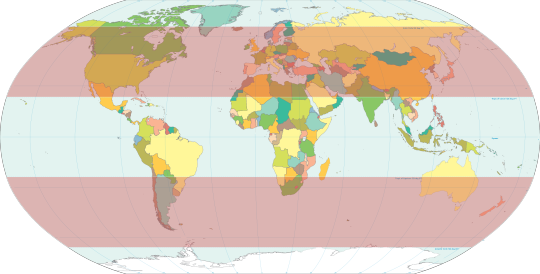
Here is a map of "temperate" latitudes, or rather, latitudes between the tropics and the polar circles (as someone who lives here, or indeed an Australian can tell you, many places there are not "temperate" at all but more on that below). What is important here is that the southern hemisphere has less places closer to the pole, except, again, Antarctica, while the northern hemisphere has lots of land near the poles. This is why we don't have our equivalents of say, Siberia, for example. The closest thing is again, Patagonia. Honestly an underused place for worldbuilding, with the steppe, the glaciers, the temperate rainforests, and the recently extinct megafauna, but I digress.
You could in fact have a tropical "north" if you keep most of the northern hemisphere's landmasses near the equator (here I'm picturing some kind of big Indonesia or Caribbean, an area where tectonic plates collide and there's lots of volcanic islands and lands), and you could place a big continent in the South to make it a cold South. Interesting reversal on the cold North/warm South of most settings.
This would bring some interesting effects, though. Placing a big landmass on any pole (not a small one like Antarctica) would lead to glaciation, as land is "colder" or rather less moderated by ocean (more on that later) and glaciers grow, and glaciers and arid land have greater albedo, reflectivity, that is, and so they reflect more sunlight, thus those place become colder, and the glaciers keep growing, and so on, until there is an ice-age. I don't have the link where I read it with me, but I recall that continents shifting to polar latitudes might have triggered ice-ages in Earth's past.
Deserts are very tricky to place. The standard worldbuilding recommendation is that the interior of the continents are drier as you get away from the sea, and that mountain chains and high terrain serves as rainshadows that stop rain from the sea. However, there is a lot more to it. A LOT more.
You can find deserts even next to oceans, in the so-called "horse latitudes", the meeting points of the Hadley Cells that circulate air from the Equator to the subtropics and beyond. The details are a bit technical, but what this means basically is that they create jet streams of circulating air at 30° South and North, keeping the climate sunny, warm and dry. This is indeed where many of the world's coastal deserts are: Atacama, Kalahari, and of course, Australia.
Meanwhile, in the equatorial zone, the "trade winds" (because they have regular wind patterns that have historical formed major sea trade routes, worldbuilding hint!) converge in the Equator, forming rainy areas... but not quite that simple.
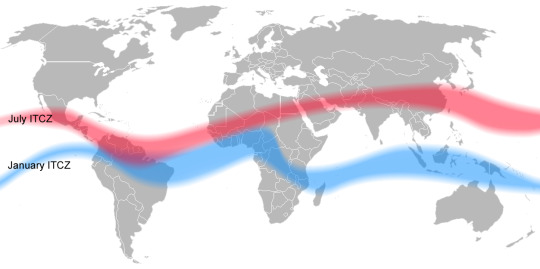
The Intertropical Convergence Zone, where these winds meet, ocsilates during the year, creating monsoons, but as always, there are lots of factors involved. In particular, given our real life scenario of rapid climate change and global warming, a warmer temperature means more intense ocsilations. This makes monsoon events sharper (more droughts and floods in those regions) and more strong La Niña/El Niño events, which are their own thing, influenced by the Pacific which is a huge factor in global climate.
And this brings me to ocean currents. Usually, being close to the ocean moderates the climate, making it more rainy and warm, or at least stable. However, if the surrounding sea is cool, it means less evaporation and less rainfall, especially if it's influenced by cool polar currents (this is the case of eastern Patagonia, for example, with the cold Malvinas Current). The opposite is the case in, for example, Europe, where the warm gulf stream moderates climate, making it warmer and rainer compared to the same latitudes in the US and Canada. I'll admit I'm not very well informed on how ocean currents work, but the depth and salinity of the ocean have much to do with it. What basically happens is that dense salty water sinks and and this works as a "conveyor belt" for warm less dense surface water to flow over it and over great distances. These currents are slow, but since the ocean is so massive, they move extensive amounts of heat across the world. I will admit defeat here and just say I don't wholly understand how it works, but I can tell you this; if your world has a less salty ocean, your currents will be less strong, which means that the differences of temperature between the poles and the tropics will be sharper as there are no strong currents to overall moderate temperature. If this is all too complex for you as it is to me, the quick cheat is just looking at this map: warm water flows from the equator, and cold water flows from the poles, and they create "gyres" around the oceans and the Equator, and cold currents contribute to colder and drier climates (note the Canary, Benguela and Peru currents, the Malvinas current is not shown for some reason...)
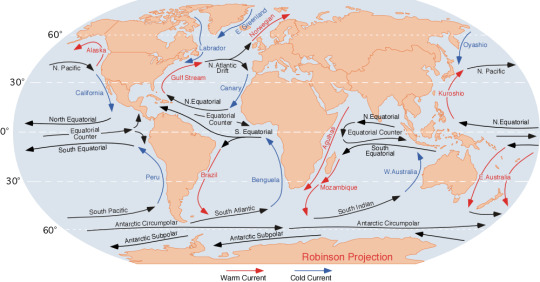
Did I forget something? Oh, yes. A colder climate of course, means less rainfall, because there is less evaporation and there is much water "trapped" in glaciers and snow. Which seems to be the case during the last ice ages. Rainforests and forests in general retreated as deserts expanded. In fact, the few forests that remained served as refugiums for species that only expanded again once the ice age was over. Some especulate that this might meant a 'weakening' of megafauna, as they were trapped in those refuges with lots of interbreeding and weakened populations when humans arrived on the scene. Here is a very interesting map:
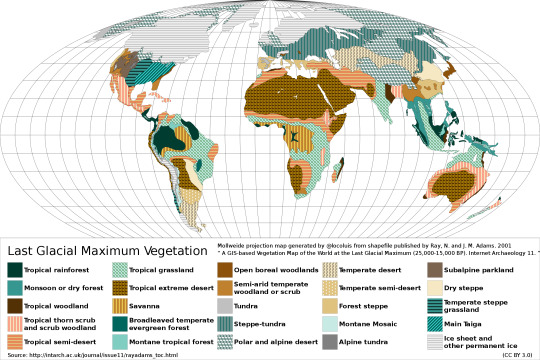
Now, there are some contradictions here and there, some researchers have said that the climate wasn't that dry and while I'm not an expert I tend to agree, many parts that are "extreme desert" there might be scrubland instead. But overall, it seems that colder times bring drier times too.
I'm still not done, but I'm almost done! According to the Biotic Pump theory, forests might also influence the climate and rainfall in a big way, basically, evapotranspiration (plants sweat, a lot, 90% of water through a plant evaporates to the atmosphere) in forests might actually create by itself the rainy environment where forests thrive, so for example, the Amazon is a rainforest BECAUSE of the forest there. I think with the increasing droughts here in South America we're seeing that theory proven in practice, as deforestation of the Mata Atlantica, the Chaco and the Amazon is causing less rainfall in the centre of the continent. Forests and plants also have a cooling effect, since they fix carbon dioxide, and also a bit of a warming effect, since they have darker albedo and so absorb more sunlight. I'm going to be very lazy and instead of reading a thousand papers say that they overall have a "moderating" effect.
Well, I could go on and on but I think I've already written way too much, so I'll leave you this to munch on a bit. It might seem like a lot, but when in doubt, you can always "eyeball" it by comparing real regions of Earth, and it will help you to create more interesting world than the omnipresent "spring-summer-fall-winter" temperate standard in so many settings.
If you have any questions, feel free to ask! Oh, and also, if you found this helpful or interesting, I would appreciate a tip to my ko-fi!
296 notes
·
View notes
Text
A while back I got a comment that demonstrated a misconception as to what the character design process actually entails, and I thought it had real "teachable moment" potential. So let me make this perfectly clear:
Drawing a character is NOT the same as designing one.
Let's say I wanted to draw a guy. No backstory, no defined personality traits or preferences, no details about his current life, just doodling some random, generic guy who popped into my head.

That's just a drawing.
But what if I decided to flesh him out more? What if I wanted his appearance to reflect his lifestyle and inner life as well? Here's where the note-taking comes in.

And now for the visual research:






I thought the bodybuilding angle would provide a fun contrast with this guy's profession. The mental image of a huge, burly dude working on a clock or watch with tiny, precise movements just makes me smile. Perhaps I could give him small, nimble hands that would suit his line of work.
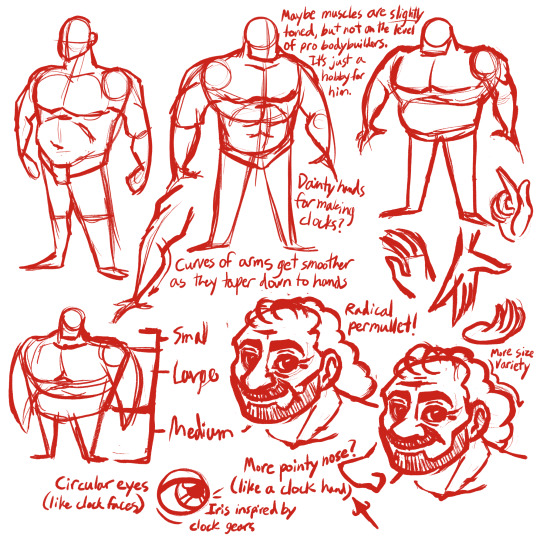

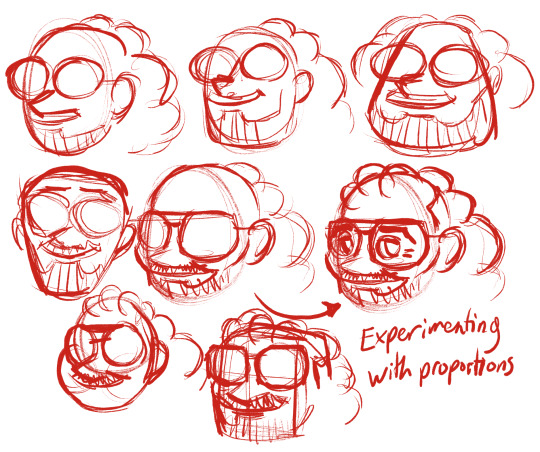
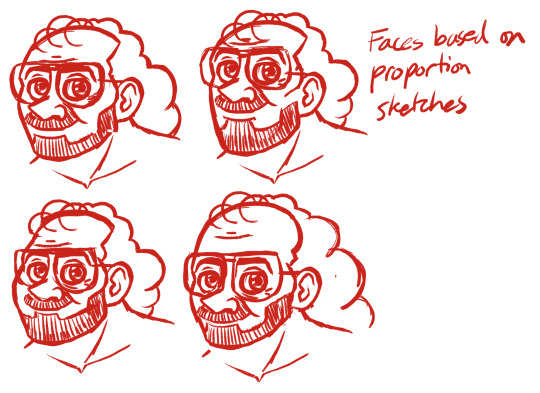
Now that I have a better idea of how Mikhail's face and body will look, it's time to establish a pose.

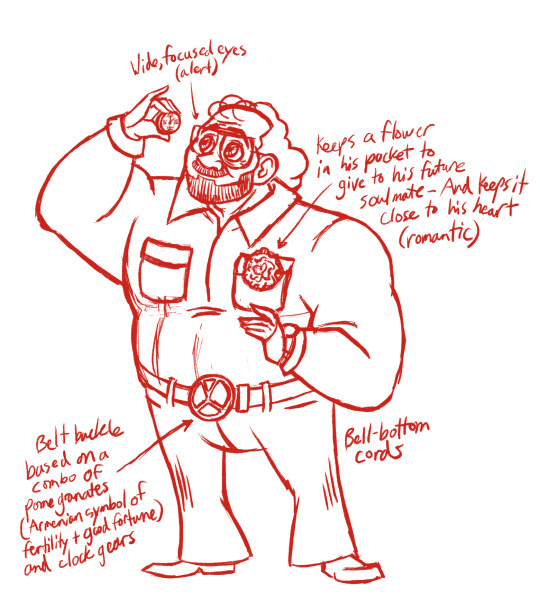
Of course, I never expected to employ all the personality traits I started out with inside this single pose; those were just a jumping-off point. No one drawing will ever be able to encapsulate every single facet of a character, unless they're extraordinarily flat and generic (see also: random guy I doodled at the start of this post). If I wanted to write a story with this guy, I'd have to figure out how all the traits play off each other and how they'd cause him to react to different situations. There would be a lot more note-taking and development involved, but for the sake of keeping this post (somewhat) brief, let's just focus on visuals for now.
On to color!
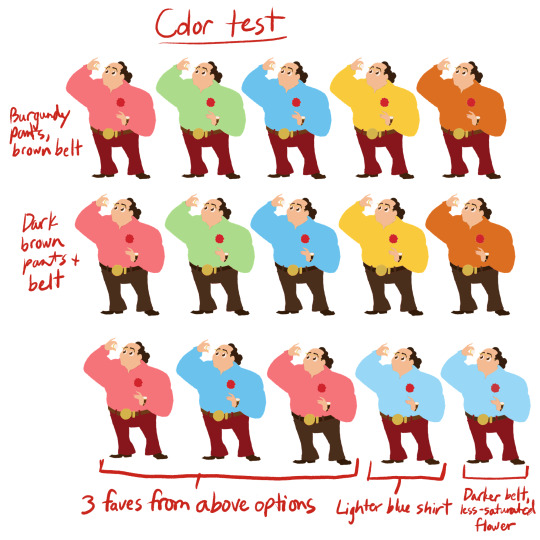
I decided to give Mikhail a carnation in his pocket (for its round shape), specifically a red one, which represents deep love and an aching heart. Thus, the flower needed to maintain its red color for the symbolism to come through.
For some reason I initially pictured this guy wearing a pink shirt (perhaps as an offshoot of the "romantic" angle), but I wanted to try some different colors inspired by the 70s catalog pages I found. I ended up really liking the contrast of the cool blue shirt with the warm red pants, and that option made it into my top three as a result. I lined them up next to each other to compare them, and in the end, blue won out over pink. I think it also reflects the "colder", more cerebral, less-emotional parts of his personality well (namely "systematic", "stern", and "callous"- one from each column!). Just goes to show that you shouldn't get too attached to your first draft, as better ideas are just around the corner.
I then lightened the blue of the shirt so it wouldn't compete so much with the rest of the outfit, and wouldn't be quite as loud and "in your face". Mikhail strikes me as a bit of an introvert, so the calmer, quieter blue is a better fit. I added a darker belt and watchband and de-saturated the flower just a bit to make the values feel more balanced, and I think we've got it!
Let's see the final result!
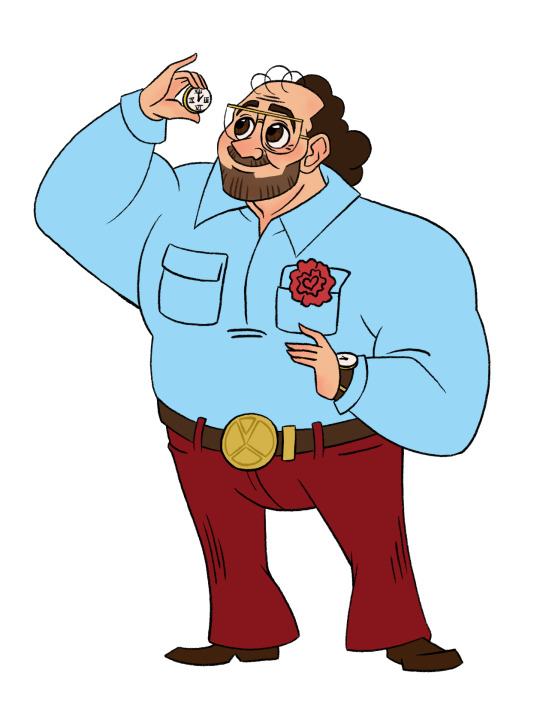
Y'all, I was not expecting this process to make me emotional, but there's something special about fully realizing a little guy you've spent hours working on. All of a sudden you look at him and go, "Oh my god, there he is. That's him." This man wasn't even a twinkle in my eye a couple weeks ago and now I'd protect him with my life.
And the thing is, the only reason I'm calling this design "done" for now is that I basically just brought it into existence to make a point. But if this dude were attached to a larger story, he'd be nowhere near finished. I'd have to make a ton more iterations and go a lot more in depth with my research than I did (especially with the Armenian cultural stuff). Overall, though, I hope this quick project properly highlighted the difference between a single drawing and a more fleshed-out character.

Later!
546 notes
·
View notes
Text
Eunuchs, Value, and Appearance– Brief Thoughts on Beauty and Gender in The Apothecary Diaries Manga Volume 1
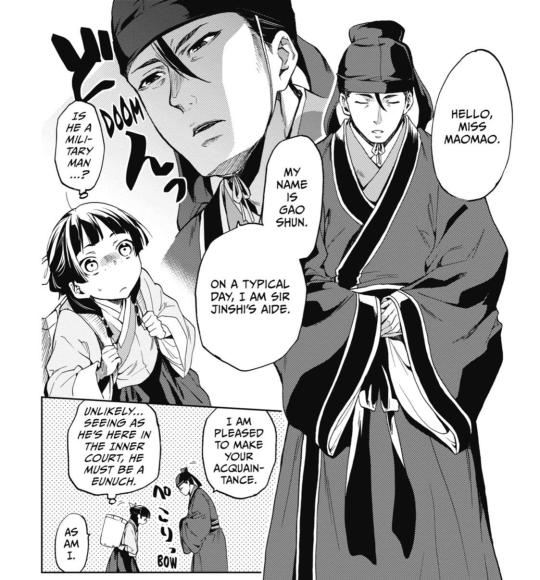
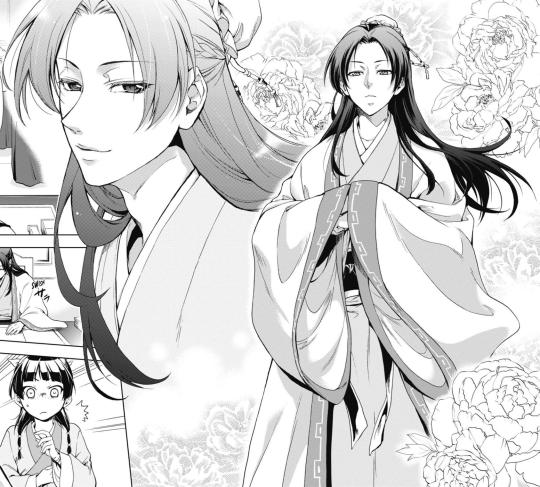
This is an offshoot of my thoughts from Ch. 4 of the manga, but it also connects greatly to Ch. 1, so a brief recap of where these thoughts sprung from:

As Maomao and Gaoshun go to investigate the "ghost" dancing on the palace wall, Maomao again reflects that Gaoshun doesn't look like a typical eunuch. Her first instinct upon meeting him was the classify him as a "military man" but because he was in the rear palace, he had to be a eunuch.
Meeting again, she thinks he looks "very masculine" and not "like a typical eunuch at all." In this moment, we get another example of Maomao's understanding of and perspective on eunuchs and gender being challenged. Or do we?
A product of her time and background, Maomao has a very specific and somewhat rigid way of thinking about gender. I think that perspective ebbs and flows, but it is very much informed by the outline provided to her by the society she exists within.
Sometimes, what first appears to challenge the constraints of that outline actually works to reaffirm it.
Gaoshun appearing more masculine and like a military man is not presented in the story to challenge a bias but it is Maomao's first clue that something else is going on with Gaoshun, that there's more to the story. It is not a purposeful reflection on gender by the author but a purposeful piece of a puzzle Maomao is solving within the story.
The same thing happens later when Maomao inspects Jinshi's body and sees it is more muscular than a eunuch's would be. Without further investigation, the presentation of eunuchs that don't fit the stereotype challenges that stereotype, but the truth of the matter actually kind of relies on and reaffirms those stereotypes. Gaoshun isn't just a eunuch and wasn't always a eunuch. Jinshi isn't a eunuch at all. If they didn't seem like regular eunuchs, it's because they are not.
[And if we flash forward to how another character is addressed–Maomao observes that Ah-Duo appears more masculine than feminine, which reminds her of Jinshi. Seems like a great challenge to gender norms, but then Maomao's bias/the binary is reinforced by the fact that Ah-Duo's womb was removed. Jinshi is castrated, thus more feminine and Ah-Duo had her womb removed, thus more masculine. Or so it seems to Maomao...]
And yet, just because these moments weren't included to say something about gender, it doesn't mean that nothing on that topic is being said. And the fact remains that Jinshi isn't actually castrated/a eunuch! So he works to both reinforce Maomao's views on gender and challenge them. Though he isn't actually a eunuch, he still appears very feminine. That is, arguably in part due to the drugs/forms of suppression he uses to assume his eunuch persona and operate in the rear palace, but even without those measures, Jinshi still possesses a great "feminine" beauty. He is sort of a contradictory figure in that sense.
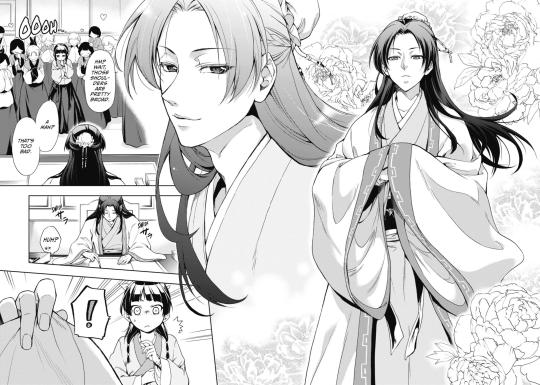
With that, I wanted to circle back to something I noted in chapter 1. I noted that Maomao is "disappointed" when she realizes Jinshi is a man and that his beauty is not possessed by a woman. I thought of this point as contributing to the conversation around gender and around beauty within the story.
I also put a pin in the idea of how Maomao values beauty and recognizes how beauty gives someone value and specifically how Maomao views beauty as it relates to Jinshi–a waste on a man, disastrously powerful on a woman, extra wasteful on a man sans frog (aka castrated).
These fuzzy reflections got some great extra translation-related context from @amiriirish (thank you for that!), specifically regarding the line "A man? That's too bad," Maomao's thought when she realizes Jinshi isn't a woman. A more accurate translation would be "A man? What a waste" or as it is written in the GX version: “'タマナシだけどな…もったいない' which roughly translates to '(He) doesn’t have balls, though. What a waste.'"
I love how @amiriirish describes Maomao's perspective in this moment as one of "a scientist, not wanting to see good genes go to waste" as within the historical context of the setting, a person's purpose is to get married and have kids/keep the family line going/pass on their genes. Jinshi being castrated means he won't be able to produce any beautiful children and so his beauty is going to waste by not being passed down.
I was pretty vague in my initial thoughts, but I meant to sort of hand-wave at these ideas (albeit in a much less articulate way) and though I do think Maomao's sexuality is another interesting conversation (and I personally favor the interpretation of her as on the asexual + bisexual spectrums), I didn't mean to highlight Maomao's attraction to Jinshi during their first meeting but rather her recognizing his general attractiveness and beauty. Love bi Maomao, but I don't actually think she was attracted to Jinshi at that moment. Like with her view of the "wastefulness" of his beauty, she is looking at him like a scientist/as more of an observer than participant.
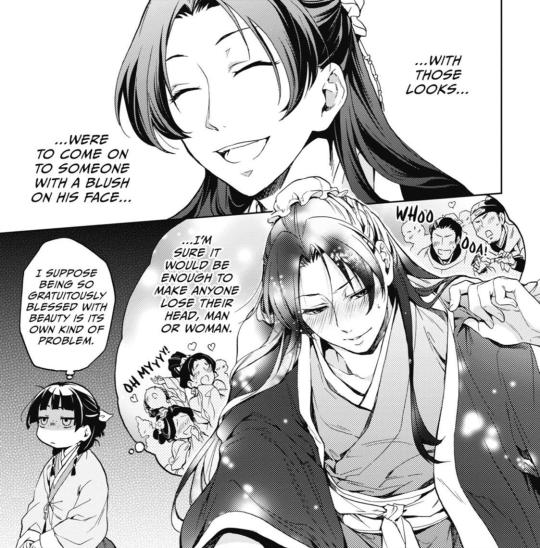
Maomao's introduction to Jinshi is the beginning of her generalizations about his beauty and how she positions herself as an outsider in those generalizations. Anyone would be attracted to him but that anyone does not refer to her. At least not yet.
Instead, I was thinking of Maomao's disappointment at Jinshi being a man rather than a woman as a reflection of her upbringing in the pleasure district and her familiarity with female beauty specifically.
We don't get a lot from Maomao about beauty or handsomeness in men. Or when we do, she seems even more removed from it. Like it isn't really worth noting. I think this is because she has learned how beauty can function as a sort of currency or tool for women.
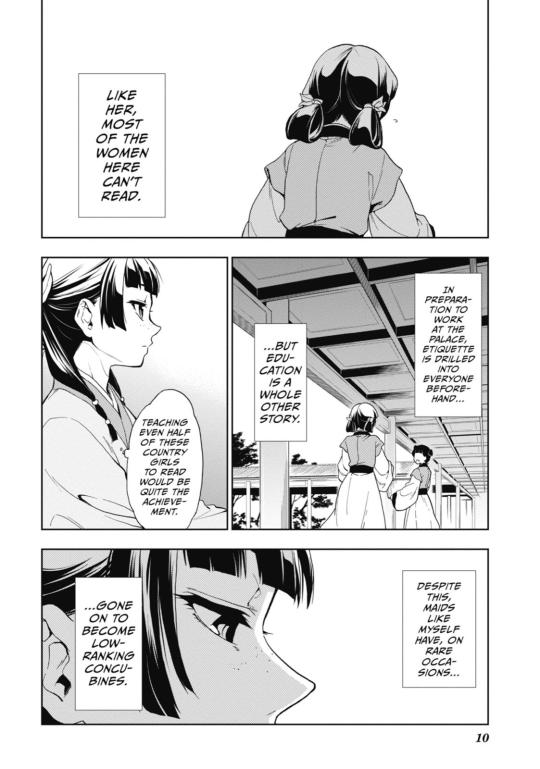
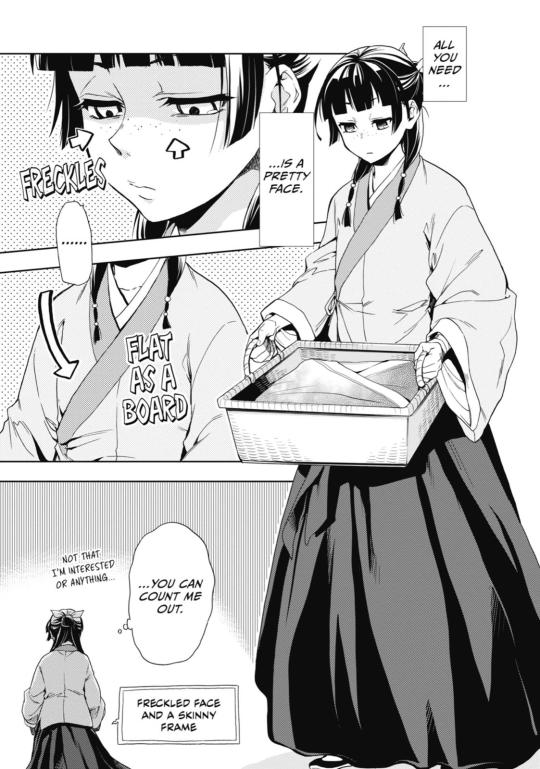
Even in the very beginning of chapter 1, Maomao reflects on how a "pretty face" (and a voluptuous body) can lead to a woman rising through the ranks.
@teaflowsthroughthesesims discussed this further in some awesome expanded thoughts:
"In the circles [Maomao] runs in beauty is power, or a means of obtaining it, mostly but not exclusively for women. In her view, it's fitting that the powerful be beautiful, and expected that it be used as a weapon or tactic of controlling others.
Beauty is also tied up in desire towards others. The desire of a customer for a courtesan is due to beauty, the desire of an emperor for a concubine naturally falls on the lovely ones -- and [Maomao's] own undesirability is tied up in her lack of beauty (i.e chicken bones vs. abalone)."
"This is why she immediately sees Jinshi's flirting as a tactic - beauty is a tool to be used. Also, she chooses ways to describe Jinshi's beauty in terms of how it would control other people - 'a nation-toppling beauty' or 'a sex appeal that would drive both men and women mad' (paraphrased)."
"Aside from her upbringing in brothels, this is also probably why it doesn't 'work' on her - she is always expecting beauty to be used as a weapon or tool."
With that being said, I think Maomao views Jinshi's beauty as a waste on a eunuch and on a man both because it means that beauty will not be genetically passed on and because it means that beauty cannot be strategically used as a tool by a woman. But after this moment of meeting, Maomao will soon see how Jinshi, despite being a eunuch and a man, can use his beauty as a tool too. Something she probably knew was a thing already (men using their looks), just something she's not as familiar with.
I think there also remains a curiosity in Maomao regarding the concept of Jinshi as a woman, which we see again later when Maomao can't resist trying out lipstick on him to try and see what he might look like if he were a woman. There's perhaps something self-indulgent in that, as well as something that brings together the world Maomao knew before and the one she is coming to know. Thinking of Maomao as a scientist, it is a little experiment, but though Maomao is practical and her view of beauty is influenced by that, I think she is more than her practicality and pragmatism too.
More thoughts in this vein will surely come once we get to Maomao's reasons for using makeup to add freckles to her face!
#Maomao#kusuriya no hitorigoto#the apothecary diaries#character analysis#beauty and power#Jinshi#maomao and jinshi#beauty and value#additional analysis#gender#analysis#gaoshun#ah duo#tad manga#knh manga#gender stereotypes
110 notes
·
View notes
Note
for clone Danny, Clone Damian
I give you
Edit Clone Talia as somehow Girlfriend of Danny, just think of the comedy
nah brO BECAUSE LITERALLY I HAVE THOUGHT BOUT THAT. Literally since the conception of Clone Danny, I have thought about it. If only for, as you said, the COMEDY of it all. Plus I love writing romance.
Literally my motto for my aus is: A) is it plausible, B) is it FUNNY (and a secret third option C) is it ANGSTY)
Clone Talia would be an offshoot au of Clone^2 because idk how she'd fit into the original timeline, bUT, she'd exist. And to avoid confusion I'll call her Nasra - I thought about Tameka (which means twin) but I like Nasra better. "Talia and Nasra" just flows so nicely doesn't it?
Idk WHY there's a clone of Talia running around -- maybe the LoA made her, maybe n unknown organization who hates Batman and knows he has romantic ties to Talia, and started making a clone of her to fuck with him and then she got nabbed by a portal when she was still Danny's age and in the middle of training. She might be like Connor (??) and have memories and thus her training is more proficient than baby Dames.
Either way, regardless of how she was made, I think it's hilarious if she, much like baby Dames, immediately attacks Danny on sight. She falls into his city and Danny only has a moment to go "goddammit not agaIN" before he's fending off a very confused, very violent Nasra. Fortunately he's able to actually try and talk to her and be at least somewhat successful -- Nasra knows english. although even if she didn't, Danny would still be somewhat successful since he knows Arabic.
Also Bruce and Danny are the battinson bat because i think that is also hilarious and 'wet rat' is STILL the perfect energy for Danny as Phantom - especially in the early days when he's running around in all but jeans and a hoodie. (and god watch me go on a rant in a separate post about his outfit and reasonings for being Phantom when he has no powers later on because it makes me go FERAL. and his active choice to look as inhuman and ghost-like through his behavior as phantom and the decision to wear such a creepy mask as possible)
(like seriously, imagine walking home late at night while danny was still in his early vigilante days (and even now when he's got damian and a better suit) and seeing a skinny figure in the shadows with sunken in black-and-glowing-green eyes, and a bone white, skull-like face, crouched on all fours like a wild animal about to pounce. THAT is the level of creepiness I was going for for clone danny)
In my head, Sam offers to house Nasra and Nasra stays with her. SAm is able to convince her parents to let her stay, or she pulls a Danny and just straight up smuggles her in and her parents are none the wiser. I also think it's funny if they have unspoken BEEF with each other. Only to later become like sisters. Nasra teaches Sam the martial arts she knows, and also Danny joins in too with Damian because goddamn he needs it even IF he's learning stuff from his mom (as per the most recent snippet post I made).
OH AND DAMIAN AND NASRA. I think it's equally as funny if they ALSO have beef with each other. Nasra is a clone of his mother (of whom he might have complicated views on due to being a clone but still is his mother) and Damian is a clone of Nasra's "son". This beef largely starts from Damian's own refusal to want to share his Danny with another clone, especially with a clone of his MOTHER.
Danny and Nasra don't become lovers for a good, long while I think. They're besties first before they even consider the idea of dating -- not only just because of the whole "uhhh our counterparts dated so it'd feel kinda weird and forced if we dated" and also because Nasra, with her newfound freedom, is busy trying to figure out herself.
A big theme here in clone^2: discovering your identity and who you are as a person when the only thing you own that's unique is your name (which isn't even the case for Damian), and figuring out if your choices are your own or because you're a clone and its something your original would have done. Nature vs Nurture and the illusion of choice and whether it really is one or not.
Also Nasra also becomes a vigilante. Danny appreciates the help but is also tearing out his hair because what the fuck is up with these assassins and becoming vigilantes?! Nasra goes by "Nesha". She's similar to Red Huntress at first where she kinda does her own thing, but is lowkey forced to team up with Danny about it because she doesn't have any proper ghost hunting equipment with her.
And then a duo becomes a trio, and Danny is spending more time with her. And they steadily become friends. Very snarky friends who are very bratty to each other, but friends. Damian still doesn't like her so Danny spends extra time during patrol keeping the two of them from making insults at each other.
"Nesha please stop fighting with a nine year old. Wraith, quit insulting Nesha."
Nasra also uses like, weaponry as Nesha which exasperates Danny a little because why are you using swords??? They're already dead its not gonna kill them,,,, If you cut off their heads its just gonna piss em off, its re-attachable. Let him ghost-proof it first too. But well, its still gonna HURT he supposes. He's still a little exasperated.
And MMM i'm sorry lmao im so focused on Nasra becoming her own person than the actual romance aspect of it all. Nasra cuts her hair short for the same/similar reasons that Danny keeps his long - to try and gain a semblance of autonomy and identity that's away from their original. Danny has his alternative rock-kinda geeky look and Nasra's got, from influence from Sam, a more alternative fashion style. Although she still leans into being feminine, which is a good challenge to Sam's belief that feminity = bad, and gets her to unlearn those bad habits since her new adoptive sister is feminine while still being an unapologetic badass.
And ykw I think Nasra gets into rollerblading and loves it. She rollerblades constantly. Damian is furious because skating is his thing (even if what he gets later on is a skateboard - skater boy damian ftw. i can see him wearing flannels and graphic tees as a teenager. very grungy/skater aesthetic. He also has a much more relaxed and teen-y speech pattern compared to DW's more formal way of talking. He also spray paints as his form of artistic medium.) and he refuses to have Nasra be a copy of him.
They will sort out their differences eventually. LMao.
Anyways they eventually do get together, but not before Danny finally has his run in with Mister Wayne. Which, they only meet because Danny starts destabilizing, and thus needs Bruce Wayne's DNA to help stabilize himself. Which that meeting in and of itself is pretty chaotic on its own, but then add clone Damian and Nasra? Bruce needs coffee.. or alcohol.
Because picture this: its late at night, you're on patrol with the rest of your family. It's like, two in the morning. You suddenly get a call in from your butler, Alfred, informing you that not one, not two, but THREE children -- two of them in their late teens and the other one not even ten yet -- showed up on your doorstep. One of them is unconscious. They are all clones.
The girl and the boy are twins - and are clones of YOU - and the girl isn't even technically YOUR clone she's a clone of your clone - and also this clone of you is your college friends' kid. And then the youngest boy is a clone of your youngest SON. Bruce is running across rooftops when he gets this call and does a literal 180 degree turn and touches the ground because he basically did a figure skating turn, and sprints back towards the manor because what the fuck? He needs to check this out.
And then half a day later a clone of your fucking ex shows up on your doorstep demanding to see the clone of you - the boy that is, not the girl - and then immediately gets into a verbal lashing with the clone of your son. Like what a fucking DAY. Your kids are equally as baffled but also laughing their asses off -- except your bio son, who is very unhappy about this turn of events and keeps getting the stink eye from his clone.
Like??? I'd quit right then and there.
While Danny recovers he's staying in Wayne manor and Damian is very reportedly not leaving his side. Ellie has to leave to help take care of Amity Park with RH, and then Nasra is also very determinedly not leaving his side either. This is her friend dammit. The first thing she does when he becomes lucid is insult him, and he insults her back - they're bantering. It's how they flirt later on. None of the Bats know how to deal with this situation.
#dpxdc#dp x dc#dp x dc crossover#dpxdc crossover#dpdc#dpdc crossover#dpdc au#dp dc#dp dc crossover#clone^2#danny fenton is a clone#danny fenton is not the ghost king#sorry this got so long and i barely even got into them falling in love with one another#satoshy you should totally reblog this so we can talk about this more i'd love to bounce ideas with you or anyone else about it 👀#this is so funny to me personally because like. im imagining nasra doesnt show up unti danny's like at least 18-19#which is a wild set of 3 years for danny because he finds out he's a clone when he's 15#acquires Damian at 16 and then meets nasra at 18#like he got one grace period where it was just him and his new little brother and then BAm another clone#damian showed up by accident but i promise you nasra was specifically clockwork's doing because its hilarious to me personally#CW loves danny but also he's a little shit. i was originally gonna call Nasra's vigilante name 'revenant' but thought it was too basic#also danny not meeting bruce until he's almost 20 is very funny to me. especially since baby dames was with the league for 6 years#beforehand#like what do you mean my clone has been living unnoticed for 18 years. he's had damian for HOW LONG? THREE YEARS?#morally gray danny has my heart ever since my post where he murdered three guys for nearly killing his brother.#nasra attacks danny and yay! he doesn't hurt his hands this time around! he's grown since he met damian. that was also a large part why dee#didn't like nasra right off the bat. she could've hurt him and made his hands even worse.
224 notes
·
View notes
Text
Are ARGs the new avant garde?
There's this unfiction ARG on YouTube about a fake video game called Valle Verde. Here's episode 1, there are three episodes:
youtube
Watch this and the other two episodes. This is the most technically impressive thing I've seen on YouTube that was made by a single person, and if you watch this video for 54 seconds you'll start to see why.
Once you've watched Valle Verde, you can read this post.
ARGs, or alternate reality games, were a natural outgrowth of creepypasta (as the great Jenny Nicholson once put it, "campfire stories on a global scale"). With creepypasta, people, usually young people, would hop onto the internet and tell a spooky story about a haunted Sonic cartridge with realistic blood or a super evil serial killer who was never caught or Slenderman or something.
Due to the memetic nature of these stories, though, there became an arms race to make them on increasingly elaborate scales. Soon, people were ROMhacking their favorite old games to actually show the spooky haunted realistic blood. A famous example, Ben Drowned, showed modded/corrupted Majora's Mask footage that was generally effective because Majora's Mask is already sort of a creepy game.
Ben Drowned was also notable for being a story that was continually updated. Originally, most creepypasta would be a single story, usually short, posted once. This is an effective medium for horror, which loses effectiveness the more things get explained, but at the same time, when people like something, they want more.
Okay, so how do you make an ongoing horror series that doesn't outright explain everything, and thus retains its horror aspect? The answer, seemingly independently reached by a wide variety of indie horror creators at the same time (Ben Drowned, Marble Hornets, and the godfather Five Nights at Freddy's) was arcane hidden lore.
That's basically what separates an ARG from creepypasta: the "game" in "alternate reality game" is that sprinkled throughout a series of videos are scraps of hints toward a broader narrative, and the viewer is expected to locate those hints, piece them together, and figure out what's actually happening.
The logic is similar to the appeal of a mystery novel, so it's no wonder this took off. Channels like Game Theory posting lore breakdowns of FNAF or other popular series raked in beaucoup views. Indie horror devs would start putting dumbass lore hints in their goofball games to piggyback off FNAF's memetic success. Pathetic things like this happened:

But ARGs are fundamentally different from a mystery novel. In a mystery novel, the terms of the mystery are overtly made known. Someone has been murdered and a world famous detective has arrived to find out who did it/how they did it. By contrast, ARGs are often abstracted to the point that it is difficult to know whether there actually is a mystery. And besides, the mystery in an ARG isn't "who is the killer," it's "what is even the plot?"
Heavily abstracted, often fragmented storylines, with no clear plot, disjointed organization, and only scattered ambiguously meaningful moments that could be arranged in any number of ways to attempt coherence. What does this remind me of?
They reinvented postmodernism!
This realization came home when Skinamarink received a theatrical release in 2022. Skinamarink was an analog horror (another offshoot branch of creepypasta/ARGs) video blown up to cinema length, created by an analog horror YouTuber based on an original 20 minute video they made. Mainstream critics who saw this film, being completely unaware of what analog horror was, extolled the film for its Lynchian, Kubrickian influences. They were unaware its actual greatest influence was Mandela Catalogue. They were unaware that a thrillingly unique, abstract form of storytelling had organically been created by a group of outsider artists on the internet.

Kubrick would be proud.
I find this especially exciting in a mainstream pop cultural milieu that is trending toward, at least in my appraisal, increasing obviousness and simplicity in how it communicates ideas, which is not only boring but also annihilates the capacity for nuance, interpretation, and even meaning itself.
This also comes alongside ARG creators often pushing themselves to new technical extremes, extremes that are absurdly impressive for individuals. Kane Pixels has created amazing found footage videos using Blender-made labyrinths. The Mandela Catalogue guy was doing some crazy shit with puppets(?) last I checked. And, of course, the act of modding old games has evolved into the act of creating whole video games entirely as a vehicle for an ARG. The first example of this I know of is Petscop, and there have been others like Catastrophe Crow (which splices in an extremely accurate pastiche of a retro gaming video essayist, plus period-accurate game magazine articles), but Valle Verde takes it to a new level.
Since you've all seen Valle Verde by now, I won't waste time explaining the seriously impressive stuff it pulls off.
Instead, I'll let the other shoe drop.
I have a fundamental problem with all these ARGs, one that pains me all the more because I am so thrilled by so many aspects of them. The problem is that once you dig into them, once you piece together the underlying narrative from all the tiny clues, interpret the ambiguities, and see the broader picture -
The picture sort of sucks.
Ben Drowned, FNAF, Petscop, Catastrophe Crow boil down to the same residual dew: Children died. (Either murdered or just tragically.) Their spirits haunt the game cartridge/animatronics. All the scant hints point to the cause. (Ben Drowned spoils it in the title.) It's not only sort of banal but also the story that you could probably guess at without reading into the deep lore, just from the story's general vibe.
It's a fundamentally boring answer to a fascinating puzzle, and worse, it reveals that there was no true value in the puzzle being presented as it was. The abstraction and postmodern technique of the narrative contribute nothing to its overall meaning. They exist with the sole aim to obfuscate, because horror only works when unexplained. Rather than leave the horror unexplained, though, the way Kubrick would in The Shining (which deliberately strips out overt explanations that exist in the book it adapts), or Lynch would in anything, these works are attempting to have their cake and eat it: there's stupid lore that explains everything, but it's just a little hard to find. In that sense, rather than being a rejection of the current cultural milieu toward works that make simple sense, this trend seems more like an attempt to reinject that milieu into one of the few genres of storytelling that had effectively rejected it. (It reads similarly to all the Babadook-inspired indie horror films of the past decade where the monster is some transparent allegory for grief or trauma or something.)
So what's the story of Valle Verde?

I won't go into a Game Theory breakdown of every symbol and detail. As far as I can tell, this is what's going on:
Valle Verde, the fiction within the fiction, is a Japanese video game developed with experimental technology called THBrain that gives it a sophisticated and advanced artificial intelligence capable of making on-the-fly alterations to the game's script. Valle Verde, the series of videos, depicts an investigation into certain malfunctioning elements of the game prior to its release. The player character, self-identified as TEST05, is actually played by two "agents" (of what agency is unclear) named Pablo and Robert testing the game and chronicling anomalous behavior.
The series of glitches and other bizarre things they record seems to depict a theological battle between Valle Verde's freemasonic villagers, led by Foxxo (remember that the next elections), and the Catholic Church, led by Pietro (possibly an avatar for St. Peter, the first pope and guardian of the gates of heaven).

Joseph of Cupertino is the patron saint of aviation. It's a "time flies" pun.
It's unclear how much autonomy either of these factions have, even knowing that there is apparently a super-sophisticated AI capable of injecting novel information. Pietro at times breaks the fourth wall and addresses Pablo directly by name; the villagers don't break the fourth wall, but do all sorts of stuff that is described by the tapes as anomalous. The AI seems like the obvious culprit, but in Valle Verde 2, Pablo actually meets the AI, who claims to have sequestered themselves from the rest of the game because they didn't want to partake in the villagers' rituals, and who has even disabled all their language libraries except Spanish to avoid comprehending the screams of the children trapped inside the game.
Oh yeah. Children are dying.
The THBrain seems to not only enable incredible AI, but is a way to upload humans into the video game (maybe this is unrelated to THBrain? I'm fuzzy on that point). Several children have already been uploaded and are presumed dead; currently, an Argentinian child named Matias is trapped in the game. Matias is the only other character besides Pietro capable of breaking the fourth wall, due to being a real person; he is aware of Pablo as an "agent" and suggests at some sort of conspiracy outside the game, which has not been explicated in much detail in the available videos.
The reason the children are dying is eventually revealed: the freemasonic villagers are sacrificing them to their false god, Moloch.

I'm not kidding about the freemasonry. Note the Argentinian flag.
There are other plot elements that are a bit murkier; Valle Verde seems to be a nexus of several unrelated video games, which can be accessed through an in-game library, and it is within this nexus that Moloch lives, and perhaps where the underlying purpose behind the villagers' actions lurk. There is also a recurring motif of a coming Christian apocalypse, likened to Noah's flood. After the freemasonic sacrifice, a doomsday clock ticks closer to midnight. Are the masons unwittingly provoking God's wrath? The series is framed as footage from 1997 that was unearthed in the modern day, so was this apocalypse averted, or did the apocalypse simply exist within the game, with no bearing on reality? The series remains ongoing; future installments may clarify.
But the underlying issue remains that, for me at least, the basic conflict in its simplicity and lack of ambiguity seems inadequately matched to the unique, impressive, and open-ended presentation. It retroactively makes me wonder what the point is of telling the story the way Valle Verde is told, if its story is in essence the Church versus Satan-worshippers, with clear moral and ideological lines drawn. Doesn't a more conventional narrative make sense for this sort of story?
There's a scene early on when the player character traverses a series of rooms corresponding to the Seven Deadly Sins. The sin of greed is depicted, not simply with stacks of gold, but with works of modern art:

As the player proceeds through the room, they discover a dumpster where Renaissance artwork by Titian and Michelangelo is trashed:

The message here is almost fatuous. It's also deeply ironic. Valle Verde is a work that has far more in common, in terms of its formalistic technique, with Picasso than Titian. Is it a lack of self-awareness that puts this here? Or perhaps something else?
The novel Infinite Jest ends abruptly, with none of its plot points resolved. In this way it's similar to the titan of American postmodern literature, Gravity's Rainbow, which peters out without explaining the conspiracy that has driven its narrative. Infinite Jest plays a trick, though, as devious as it is facile. The final 200 pages of the book have been cut off and moved to the front. The story's beginning is a flash forward that, in its lack of context and confusing abstractions, is difficult to make sense of on first read. Upon rereading after finishing the book, though, it clearly contains the answers to all the unresolved plot threads.
If postmodernism could be described as an artistic period of uncertainty and obscured truth that was a response to the similarly uncertain Cold War era, where the inner machinations of governments may at any time cause the annihilation of the entire world, then what Infinite Jest did, published just a few years after the Cold War's end, could be seen as a reclamation of truth.
Truth itself is a concept deeply interwoven with Christianity. In Valle Verde, Pietro even calls it out with a green highlight to indicate its importance:

La Verdad sounds suspiciously similar to Valle Verde. Coincidence?
The context of this quote comes after the villagers destroy the church; Pietro reassures the player that La Verdad remains unchanging, and that this tribulation shall pass.
Might Valle Verde itself then be an Infinite Jest style reclamation, using the formalistic techniques of postmodernism that are so useful for obscuring truth to obscure what is, at its core, a simple and morally black-and-white tale of Christianity versus wicked idolatry?
There is a real-world allegorical undercurrent to Valle Verde that makes this reading even more appealing. Valle Verde's creator, Alluvium, is Argentinian, and the game is steeped in references to Argentinian history and politics.

That's a map of the Falkland Islands and a picture of former Argentine dictator Juan Peron.
At one point, when the villagers destroy the church (with the unwitting? help of the player character, who seems to have no moral interest in anything happening, and who only does whatever anyone asks him, whether it's Pietro or Foxxo), a highly overt reference is made to the death of Pope John Paul I, who reigned for only 33 days in the late 1970s before he died, officially, of a heart attack. The abruptness of his death, and the failure of the corrupt, Mafia- and freemason-connected Vatican Bank in the years that followed, have led to conspiracy theories that John Paul was actually murdered by freemasons within the Vatican so that they may continue to corrupt the Catholic Church.
Specifically, the conspiracy posits the assassination was done by the freemasonic branch P2, or Propaganda Due, an illegal fascistic secret society that contained many high-ranking members of Italian politics (including Silvio Berlusconi), whose goal was to act as a shadow government that could prevent the rise of communism within Italy. (P2 definitely existed; how much it actually influenced Italian politics is a matter of debate.)
Though primarily an Italian organization, P2 had several influential members from other countries, notably Argentina, where several politicians and military leaders at the highest levels were involved. As a nation, Argentina is something of a tragedy; at one point considered a rising economic powerhouse, its excellent geographic and demographic advantages were squandered by a long succession of corrupt leaders, including those involved in P2. It makes sense, then, why an Argentinian creator like Alluvium might be so interested in critiquing the evils of freemasonic corruption.
Valle Verde satirizes Argentina's leadership via Foxxo, not only through his freemasonic devil rituals, but also in more down-to-earth ways. In his introduction, Foxxo provides the player character 100 coins, telling him to "remember that the next elections" (Foxxo's catchphrase, despite him clearly stating he has been given absolute authority over the area by The Smiling One); moments later, when the player turns to leave, Foxxo mugs him from behind and puts him 99,999 coins in debt.

Through the use of masonic slogans like liberté, égalité, fraternité (which is written over what appears to be a portal to Hell) and masonic symbols such as the Statue of Liberty and Washington Monument, there's an undercurrent that expands this freemasonic secular/Satanic conspiracy beyond Argentinian politics and into the post-Enlightenment secular governments that have come to rule the so-called free world. "Progress is God," the freemasons state during their child sacrifice ritual. (Foxxo is joined in this scene by the village's museum curator, representing knowledge, and its scientist, representing progress.)
It's this kind of framing that makes me wonder about the previous scene depicting Picasso paintings as emblematic of the sin of Greed, compared to Renaissance paintings in the dumpster; is there a general theme here raging against modernity in all its forms, compared to a fundamentally good and absolute Christian religious truth? If so, it makes sense why Valle Verde is presented as it is, so abstractly; it shows a world rendered incomprehensible by modernity, but one that can be sifted and parsed to find incontrovertible religious salvation still shining underneath.
It is a rejection of "progress," using the formal techniques of "progress." In a milieu where the promises of the Enlightenment seem to have hit a dead end, where the freedom secularism once promised has given rise to corruption and abuses akin to those the Catholic Church of the Renaissance once inflicted, perhaps the sense of going back appeals.
The English literary world post-Infinite Jest itself also seems to have returned to the past; the works published today are realistic in style and scope, eschewing most formal techniques pioneered across the preceding century. Though I doubt that was David Foster Wallace's goal, it's what he created. Valle Verde, which is so explicit in its fundamental belief in Christianity, is probably far more deliberate in its rejection of the world as it currently exists.
Though there have always been voices calling for a return to the past, perhaps this is a mindset particularly enticing in the information age, when meaning seems so fragmented as to be ungraspable. Though Valle Verde is conscious of what it is doing formally in a way that, say, Ben Drowned is not, the inner simplicity of these ARG narratives obfuscated by abstraction strikes me as a collective yearning for clearly explicated, graspable truths in a world where such a thing seems increasingly impossible. Almost a fantasy: If only this incomprehensible eldritch horror could be explained by a 10-minute Game Theory video!
(The eldritch itself is a horror rooted in incomprehensibility. Making it explicable banishes it entirely, the way the protagonist of Valle Verde banishes a demon by holding aloft a crucifix. La Verdad triumphs. Couldn't our lives be so simple?)
Not every ARG is like this. Kane Pixels, another creator I would highlight for their exceptional technical talent and avant garde storytelling, has created far more nuanced and ambiguous narratives with works like The Oldest View, which deals with themes of nostalgia and memory without being resolvable into a simple pat sentence synopsis. Overall, I consider this entire collection of web original horror creators to be blessed with both the talent and mindset to create truly innovative works of fiction, even if many of them are outsider artists fumbling around just trying to scare someone; as outsiders, these confused anti-confusions of theme and meaning might be par for the course.
Valle Verde is an impressive work of art, even if it is an avant garde work that paradoxically rejects itself. Perhaps in that paradox more could be said than had it remained fully self-consistent. Either way, I eagerly await what comes next.
67 notes
·
View notes
Text

The Caduceus
Hermes, personifying the dual powers of the Secret Wisdom, carries in his right hand a powerful symbol which represents the breathing in and breathing out of the cosmos and unites all the dual aspects of manifested existence. The caduceus of Hermes was said to have been given him by Apollo. It is a wand with two serpents twined round it, surmounted by two wings. The ancient Greeks believed it to exercise influence over the living and the dead, bestow wealth and prosperity, and turn everything it touched into gold. They called it Kerykeion, 'herald's wand' – it was the emblem of heralds and ambassadors, giving them power and inviolability. While the rod represents power, the serpents symbolize wisdom.
The wings of the caduceus symbolize the 'winged radiance' of those who have achieved the dynamic equilibrium of the two lobes of the medulla, the petals of the third-eye chakra, as well as the lightning speed of Hermes as Messenger of the Gods. Like the twining serpents, Hermes is known as the equilibrator, balancing the pairs of opposites, inspiring the alchemist's belief that without him neither Isis nor Osiris could accomplish the Great Work. The caduceus also symbolizes the fall of spirit into matter from the archetypal world to the creative and formative worlds and finally to the material world. Thus it essentially represents the astral light, the means through which Hermes wields his great power of transformation. The astral light is variously described as an "ambient and all-penetrating fluid . . . a ray detached from the (Spiritual) Sun's splendour," – the girdle of Isis that twines around two poles, and the winged dragon of Medea as well as the double serpent of the caduceus. It is the vehicle of life, representing time and eternity: the tempter and the redeemer. The wings of the caduceus signify the spiritual transcendence of time and temptation.
The rod of the caduceus is called a 'laya rod,' a central staff surrounded by the positive and negative energy of the serpents. It is the neutral Sushumna, the channel of the Sun's One Ray. All wands and staffs of power derive from this idea, just as the guiding power of Hermes is reflected in the prayer to the Christos which promises, "Yea, though I walk through the valley of the shadow of death I shall fear no evil; for thou art with me, thy rod and thy staff they comfort me." The magician's wand, the 'baton de commandement' of ancient cave-paintings, and the lightning rod, are all aspects symbolic of a principle of controlled power.
On the western pediment of the Temple of Artemis at Corfu is a gorgon figure flanked by two lions. She stands in a 'pinwheel stance' which conveys movement without locomotion. Around her waist are coiled two serpents, entwined at the front, their heads arching back to face one another at her bodice. She is a guardian warding off evil and protecting the goddess within. As such, this stone figure represents protection through balanced duality. For the Great Serpent in the Garden of Eden and the 'Lord God' are one. Or, as the ancients taught, "Demon est Deus Inversus."
Agathodaemon and Kakodaemon are offshoots from the same tree of being, and evil is a force which is antagonistic but essential to good, giving it vitality and existence. These two entwined serpents, symbolizing the astral light which is not only the vehicle of life but the auxiliary of good and evil, reflect that matrix which ever seeks equilibrium. As long as nature remains 'untamed,' the opposition of the two forces (quicksilver and sulphur) manifests in a destructive mode. Hermes (Mercury) introduces the equilibrating element. The Hebrews called the astral light OD-OB-AOUR or 'Great Agent of Life.' The magnetism directed by the active will represented the right-hand serpent of the caduceus or OD. The left-hand serpent symbolized the passive OB. The golden globe at the summit of the rod was AOUR or 'equilibrating light,' the neutral point. The secret of magnetism could be mastered through ruling the fatality of OB with the intelligent power of OD, thereby gaining the perfect equilibrium of AOUR.
The solar and lunar spirals describe forces unfolding outward and simultaneously turning inward. They represent the expanding and contracting forces of nature, the alternating yin and yang, the two halves of the world egg as well as of the brain. A continuous oscillation between the two serpents accompanies the involution and evolution of spirit. The involution of spirit into matter is a progressive downward cycling, the 'sliding down of Aeons' of the Alexandrian Gnostics. The 'Downfall of Pleroma' (Gods and Devas) is allegorized as 'the desire to learn and acquire knowledge.' The seven 'rectors' break through the 'seven circles of fire.' These are the seven Devas who were born to act in space and time, to break through the seven circles of the super-spiritual planes into the phenomenal world. Allegorically, they rebelled against God.
In the nineteenth century 'primitive matter' was thought to have been formed by the act of a 'generative force' throwing off atoms endowed with varying forms of energy. It was believed by some that lowering temperatures and electricity within the 'original protyle' conferred upon newly-born elements their particular atomicity. Sir William Crookes, an intuitive chemist, pointed out that double spirals describe the process by which the elements originate. Such a figure would comprise three simultaneous oscillating motions, each at right angles to the other. Projecting this figure in space, curves describe loci where various chemical elements form within one cycle of oscillation. In the next cycle, conditions of temperature and time would have changed and the atomic groupings would be lineal descendants of the first group; and so the process would continue. Projected in space, the curve shows a central neutral line relating to electrical and chemical properties, with a positive spiral on the north, a negative on the south. This strongly echoes the metaphysics embodied in the caduceus. Though limited to material genesis, scientists have suggested that eventually matter would be reabsorbed into 'the point neutral as to electricity' or the 'zero point' analogous to the neutral globe at the summit of the caduceus rod – what The Secret Doctrine terms the "Inter-etheric point" upon which the universe revolves, a laya point, "which hiding place can be traced in the world of matter." Rotating neutral centers fixed by Fohat carry the full load of accumulated atoms from the start, and remain balanced.
The Divine Pyrnander teaches that "the Gods distinguished the Nature full of Seeds. And when all things were interminated and unmade up, the light things were divided on high and the heavy things were founded upon the moist Sand." When things were formed, they were sustained by Spirit and "Heaven was seen in Seven Circles . . . The Gods were seen in their Ideas of the Stars . . . and the Sphere was lined with air, carried about in a circular motion by the Spirit of God." Similarly, in modern astronomy, scientists speak of whirling gases made up of light hydrogen atoms evolving into heavier elements by 'spontaneous synthesis.' This cosmo-chemical process is described as unfolding in the same oscillating, caduceus-like pattern. Hydrogen atoms, the first of the series, are able to bind and to release a second electron, and in the absorption and emission of the necessary small amount of energy, all the wavelengths of the hydrogen spectrum are evolved. Since all further color distinctions are due to similar atomic and electro-magnetic variants, it would seem to follow that the potential for subsequent evolution exists at the earliest point. The unfolding spectrum can be related to the serpentine oscillation producing the original elements. In the language of the ancients, the Seven Devas break through spiritual planes into the phenomenal realms. Spirit involves into matter, its manifested spectrums circling down in series through the astral matrix.
These dual forces conjoin at the center of the seven-fold nature of man. The full force of the conjunction of the lunar and the solar serpents is uniquely experienced in human nature, and the perfected man who has balanced these universal forces is, like Hermes, a God of the Crossroads and a Mediator between Two Worlds. At the point of intersection between the macrocosm and the microcosm stands man. This is 'the cave of the heart,' the battleground of the dual forces of life. The vertical axis is the road of descending and ascending power. The horizontal axis is the manifestation of this in the world. Strong interaction of the contrasting forces along the two axes produces a spiralling motion that is the basis for identifying the aspiring disciple with the uncoiling serpent, and the perfected men of all ages as Nagas or Dragons of Wisdom.
Through his sacrifice the Serpent-Saviour initiates a new winding on the spiral of the next dimension, marking the beginning of a New Age. He is like The Redeemer on the cross. Through him man pulls himself up at the moment of death into the lunar foundations of the next world. The Adept who touches the earth like the serpent's tail sacrifices his life to lift up the whole in his journey back to his Spiritual Seat. He is the Spiralled Serpent of the Tree of Life.
The trunk of the Asvatta tree grows from heaven and descends at every Beginning from the two dark wings of the Swan of Life. The two Serpents, the ever-living and its illusion (spirit and matter) whose two heads grow from the one head between the wings, descend along the trunk, interlacing in close embrace. The two tails join on earth (the manifested universe) into one, and this is the great illusion.
Ophios and Ophiomorphos, Apollo and Python, Osiris and Typhon, Christos and the Serpent, are all convertible terms, all Logoi. "One is unintelligible without the other." They are spiritual saviours and physical regenerators; the former ensure immortality for the Divine Spirit and the latter give it through regeneration of the seed. The serpent or saviour has to die because he reveals the secret of the Immortal Ego.
Human consciousness is related to the balancing and flow of subtle energy currents. The Sakti of Siva actively revolves around the Siva lingham, the neutral rod of the caduceus. The lotus centers in the body are pierced by the Sakti energy passing into progressively finer vibrations. The Buddha termed this 'the untying of all the knots in the inverse order.' Man approaches the Divine through spiral stages of initiation. Apollonius of Tyana spoke of the Second Hour when "by the duad, the zodiacal fish chant the praises of God; the fiery serpents entwine about the caduceus and the thunder becomes harmonious." This is one of twelve zodiacal steps of successive initiation, another being to study the balanced forces in nature and learn how harmony results from the analogy of contraries, "to know the Great Magical Agent and two-fold polarization of universal light."
The Emerald Tablet of Hermes Trismegistus bears the following inscription "The power is vigorous if it be changed into earth . . . Ascend with the greatest sagacity from earth to heaven, and then again descend to earth, and unite together the power of things superior with things inferior." Such is the practice of theurgy which involves communication with, and bringing down to earth, planetary spirits and angels. Total purity of mind, heart and body is needed to perform this sublime magic. In the school of Iamblichus, priests who evoked gods during the Mysteries were Hierophants. Like the Brahman Grihasta, the Theurgist liberated his own astral body, which then took on the form of the God and served as a medium through which the "special current preserving ideas and knowledge of that God could be reached and manifested." Through theurgy, the initiated disciple ascends the spiral to communicate with the Augoeides rendered visible through the medium of his astral body.
The magic of theurgy and the art of healing are alike based upon the principle of establishing an equilibrium of forces. Because human nature denotes the polarity of spirit and matter, a struggle between the two manifests. Since the centripetal and centrifugal forces are interdependent, if the action of one is obstructed, the action of the other will immediately become self-destructive. There must be a restoration of equilibrium so that the currents of life can perform their proper function in the body. The Navajo medicine man carefully delineates a design in colored sand which precisely combines the correct elements of color, symbol, direction and balance. In the center of this mandala the patient will remain seated throughout the lengthy chanting which, together with the sand-painting, will evoke the contrasting forces in nature necessary to re-establish the proper equilibrium in the patient.
The knowledge needed to heal oneself is the same as that needed to ascend the spiral of initiation into the still center of the Higher Self. The great shadow of the astral light ever deludes man and the shadow-serpent entwined around him obscures his vision. Let man mark that serpent well and understand its essential force while turning his mind ever upward toward the Spiritual Sun. The ardent disciple strives to realize Siva through the balanced forces of his whole nature, thus embodying every aspect of the golden caduceus. This is the natural potential of man. The perfect balance achieved, the soul soars upward on radiant wings.
Tree of Life as the Caduceus of Mercury. Each number corresponds to a planet/god e.g. 8 is Mercury, 7 is Venus etc.
The serpents represent the Ida and Pingala nadis, while the shaft/wand is Sushumna.
Image from “The Book of Thoth” by Aleister Crowley (1944).
80 notes
·
View notes
Text
"Open" "AI" isn’t

Tomorrow (19 Aug), I'm appearing at the San Diego Union-Tribune Festival of Books. I'm on a 2:30PM panel called "Return From Retirement," followed by a signing:
https://www.sandiegouniontribune.com/festivalofbooks

The crybabies who freak out about The Communist Manifesto appearing on university curriculum clearly never read it – chapter one is basically a long hymn to capitalism's flexibility and inventiveness, its ability to change form and adapt itself to everything the world throws at it and come out on top:
https://www.marxists.org/archive/marx/works/1848/communist-manifesto/ch01.htm#007
Today, leftists signal this protean capacity of capital with the -washing suffix: greenwashing, genderwashing, queerwashing, wokewashing – all the ways capital cloaks itself in liberatory, progressive values, while still serving as a force for extraction, exploitation, and political corruption.
A smart capitalist is someone who, sensing the outrage at a world run by 150 old white guys in boardrooms, proposes replacing half of them with women, queers, and people of color. This is a superficial maneuver, sure, but it's an incredibly effective one.
In "Open (For Business): Big Tech, Concentrated Power, and the Political Economy of Open AI," a new working paper, Meredith Whittaker, David Gray Widder and Sarah B Myers document a new kind of -washing: openwashing:
https://papers.ssrn.com/sol3/papers.cfm?abstract_id=4543807
Openwashing is the trick that large "AI" companies use to evade regulation and neutralizing critics, by casting themselves as forces of ethical capitalism, committed to the virtue of openness. No one should be surprised to learn that the products of the "open" wing of an industry whose products are neither "artificial," nor "intelligent," are also not "open." Every word AI huxters say is a lie; including "and," and "the."
So what work does the "open" in "open AI" do? "Open" here is supposed to invoke the "open" in "open source," a movement that emphasizes a software development methodology that promotes code transparency, reusability and extensibility, which are three important virtues.
But "open source" itself is an offshoot of a more foundational movement, the Free Software movement, whose goal is to promote freedom, and whose method is openness. The point of software freedom was technological self-determination, the right of technology users to decide not just what their technology does, but who it does it to and who it does it for:
https://locusmag.com/2022/01/cory-doctorow-science-fiction-is-a-luddite-literature/
The open source split from free software was ostensibly driven by the need to reassure investors and businesspeople so they would join the movement. The "free" in free software is (deliberately) ambiguous, a bit of wordplay that sometimes misleads people into thinking it means "Free as in Beer" when really it means "Free as in Speech" (in Romance languages, these distinctions are captured by translating "free" as "libre" rather than "gratis").
The idea behind open source was to rebrand free software in a less ambiguous – and more instrumental – package that stressed cost-savings and software quality, as well as "ecosystem benefits" from a co-operative form of development that recruited tinkerers, independents, and rivals to contribute to a robust infrastructural commons.
But "open" doesn't merely resolve the linguistic ambiguity of libre vs gratis – it does so by removing the "liberty" from "libre," the "freedom" from "free." "Open" changes the pole-star that movement participants follow as they set their course. Rather than asking "Which course of action makes us more free?" they ask, "Which course of action makes our software better?"
Thus, by dribs and drabs, the freedom leeches out of openness. Today's tech giants have mobilized "open" to create a two-tier system: the largest tech firms enjoy broad freedom themselves – they alone get to decide how their software stack is configured. But for all of us who rely on that (increasingly unavoidable) software stack, all we have is "open": the ability to peer inside that software and see how it works, and perhaps suggest improvements to it:
https://www.youtube.com/watch?v=vBknF2yUZZ8
In the Big Tech internet, it's freedom for them, openness for us. "Openness" – transparency, reusability and extensibility – is valuable, but it shouldn't be mistaken for technological self-determination. As the tech sector becomes ever-more concentrated, the limits of openness become more apparent.
But even by those standards, the openness of "open AI" is thin gruel indeed (that goes triple for the company that calls itself "OpenAI," which is a particularly egregious openwasher).
The paper's authors start by suggesting that the "open" in "open AI" is meant to imply that an "open AI" can be scratch-built by competitors (or even hobbyists), but that this isn't true. Not only is the material that "open AI" companies publish insufficient for reproducing their products, even if those gaps were plugged, the resource burden required to do so is so intense that only the largest companies could do so.
Beyond this, the "open" parts of "open AI" are insufficient for achieving the other claimed benefits of "open AI": they don't promote auditing, or safety, or competition. Indeed, they often cut against these goals.
"Open AI" is a wordgame that exploits the malleability of "open," but also the ambiguity of the term "AI": "a grab bag of approaches, not… a technical term of art, but more … marketing and a signifier of aspirations." Hitching this vague term to "open" creates all kinds of bait-and-switch opportunities.
That's how you get Meta claiming that LLaMa2 is "open source," despite being licensed in a way that is absolutely incompatible with any widely accepted definition of the term:
https://blog.opensource.org/metas-llama-2-license-is-not-open-source/
LLaMa-2 is a particularly egregious openwashing example, but there are plenty of other ways that "open" is misleadingly applied to AI: sometimes it means you can see the source code, sometimes that you can see the training data, and sometimes that you can tune a model, all to different degrees, alone and in combination.
But even the most "open" systems can't be independently replicated, due to raw computing requirements. This isn't the fault of the AI industry – the computational intensity is a fact, not a choice – but when the AI industry claims that "open" will "democratize" AI, they are hiding the ball. People who hear these "democratization" claims (especially policymakers) are thinking about entrepreneurial kids in garages, but unless these kids have access to multi-billion-dollar data centers, they can't be "disruptors" who topple tech giants with cool new ideas. At best, they can hope to pay rent to those giants for access to their compute grids, in order to create products and services at the margin that rely on existing products, rather than displacing them.
The "open" story, with its claims of democratization, is an especially important one in the context of regulation. In Europe, where a variety of AI regulations have been proposed, the AI industry has co-opted the open source movement's hard-won narrative battles about the harms of ill-considered regulation.
For open source (and free software) advocates, many tech regulations aimed at taming large, abusive companies – such as requirements to surveil and control users to extinguish toxic behavior – wreak collateral damage on the free, open, user-centric systems that we see as superior alternatives to Big Tech. This leads to the paradoxical effect of passing regulation to "punish" Big Tech that end up simply shaving an infinitesimal percentage off the giants' profits, while destroying the small co-ops, nonprofits and startups before they can grow to be a viable alternative.
The years-long fight to get regulators to understand this risk has been waged by principled actors working for subsistence nonprofit wages or for free, and now the AI industry is capitalizing on lawmakers' hard-won consideration for collateral damage by claiming to be "open AI" and thus vulnerable to overbroad regulation.
But the "open" projects that lawmakers have been coached to value are precious because they deliver a level playing field, competition, innovation and democratization – all things that "open AI" fails to deliver. The regulations the AI industry is fighting also don't necessarily implicate the speech implications that are core to protecting free software:
https://www.eff.org/deeplinks/2015/04/remembering-case-established-code-speech
Just think about LLaMa-2. You can download it for free, along with the model weights it relies on – but not detailed specs for the data that was used in its training. And the source-code is licensed under a homebrewed license cooked up by Meta's lawyers, a license that only glancingly resembles anything from the Open Source Definition:
https://opensource.org/osd/
Core to Big Tech companies' "open AI" offerings are tools, like Meta's PyTorch and Google's TensorFlow. These tools are indeed "open source," licensed under real OSS terms. But they are designed and maintained by the companies that sponsor them, and optimize for the proprietary back-ends each company offers in its own cloud. When programmers train themselves to develop in these environments, they are gaining expertise in adding value to a monopolist's ecosystem, locking themselves in with their own expertise. This a classic example of software freedom for tech giants and open source for the rest of us.
One way to understand how "open" can produce a lock-in that "free" might prevent is to think of Android: Android is an open platform in the sense that its sourcecode is freely licensed, but the existence of Android doesn't make it any easier to challenge the mobile OS duopoly with a new mobile OS; nor does it make it easier to switch from Android to iOS and vice versa.
Another example: MongoDB, a free/open database tool that was adopted by Amazon, which subsequently forked the codebase and tuning it to work on their proprietary cloud infrastructure.
The value of open tooling as a stickytrap for creating a pool of developers who end up as sharecroppers who are glued to a specific company's closed infrastructure is well-understood and openly acknowledged by "open AI" companies. Zuckerberg boasts about how PyTorch ropes developers into Meta's stack, "when there are opportunities to make integrations with products, [so] it’s much easier to make sure that developers and other folks are compatible with the things that we need in the way that our systems work."
Tooling is a relatively obscure issue, primarily debated by developers. A much broader debate has raged over training data – how it is acquired, labeled, sorted and used. Many of the biggest "open AI" companies are totally opaque when it comes to training data. Google and OpenAI won't even say how many pieces of data went into their models' training – let alone which data they used.
Other "open AI" companies use publicly available datasets like the Pile and CommonCrawl. But you can't replicate their models by shoveling these datasets into an algorithm. Each one has to be groomed – labeled, sorted, de-duplicated, and otherwise filtered. Many "open" models merge these datasets with other, proprietary sets, in varying (and secret) proportions.
Quality filtering and labeling for training data is incredibly expensive and labor-intensive, and involves some of the most exploitative and traumatizing clickwork in the world, as poorly paid workers in the Global South make pennies for reviewing data that includes graphic violence, rape, and gore.
Not only is the product of this "data pipeline" kept a secret by "open" companies, the very nature of the pipeline is likewise cloaked in mystery, in order to obscure the exploitative labor relations it embodies (the joke that "AI" stands for "absent Indians" comes out of the South Asian clickwork industry).
The most common "open" in "open AI" is a model that arrives built and trained, which is "open" in the sense that end-users can "fine-tune" it – usually while running it on the manufacturer's own proprietary cloud hardware, under that company's supervision and surveillance. These tunable models are undocumented blobs, not the rigorously peer-reviewed transparent tools celebrated by the open source movement.
If "open" was a way to transform "free software" from an ethical proposition to an efficient methodology for developing high-quality software; then "open AI" is a way to transform "open source" into a rent-extracting black box.
Some "open AI" has slipped out of the corporate silo. Meta's LLaMa was leaked by early testers, republished on 4chan, and is now in the wild. Some exciting stuff has emerged from this, but despite this work happening outside of Meta's control, it is not without benefits to Meta. As an infamous leaked Google memo explains:
Paradoxically, the one clear winner in all of this is Meta. Because the leaked model was theirs, they have effectively garnered an entire planet's worth of free labor. Since most open source innovation is happening on top of their architecture, there is nothing stopping them from directly incorporating it into their products.
https://www.searchenginejournal.com/leaked-google-memo-admits-defeat-by-open-source-ai/486290/
Thus, "open AI" is best understood as "as free product development" for large, well-capitalized AI companies, conducted by tinkerers who will not be able to escape these giants' proprietary compute silos and opaque training corpuses, and whose work product is guaranteed to be compatible with the giants' own systems.
The instrumental story about the virtues of "open" often invoke auditability: the fact that anyone can look at the source code makes it easier for bugs to be identified. But as open source projects have learned the hard way, the fact that anyone can audit your widely used, high-stakes code doesn't mean that anyone will.
The Heartbleed vulnerability in OpenSSL was a wake-up call for the open source movement – a bug that endangered every secure webserver connection in the world, which had hidden in plain sight for years. The result was an admirable and successful effort to build institutions whose job it is to actually make use of open source transparency to conduct regular, deep, systemic audits.
In other words, "open" is a necessary, but insufficient, precondition for auditing. But when the "open AI" movement touts its "safety" thanks to its "auditability," it fails to describe any steps it is taking to replicate these auditing institutions – how they'll be constituted, funded and directed. The story starts and ends with "transparency" and then makes the unjustifiable leap to "safety," without any intermediate steps about how the one will turn into the other.
It's a Magic Underpants Gnome story, in other words:
Step One: Transparency
Step Two: ??
Step Three: Safety
https://www.youtube.com/watch?v=a5ih_TQWqCA
Meanwhile, OpenAI itself has gone on record as objecting to "burdensome mechanisms like licenses or audits" as an impediment to "innovation" – all the while arguing that these "burdensome mechanisms" should be mandatory for rival offerings that are more advanced than its own. To call this a "transparent ruse" is to do violence to good, hardworking transparent ruses all the world over:
https://openai.com/blog/governance-of-superintelligence
Some "open AI" is much more open than the industry dominating offerings. There's EleutherAI, a donor-supported nonprofit whose model comes with documentation and code, licensed Apache 2.0. There are also some smaller academic offerings: Vicuna (UCSD/CMU/Berkeley); Koala (Berkeley) and Alpaca (Stanford).
These are indeed more open (though Alpaca – which ran on a laptop – had to be withdrawn because it "hallucinated" so profusely). But to the extent that the "open AI" movement invokes (or cares about) these projects, it is in order to brandish them before hostile policymakers and say, "Won't someone please think of the academics?" These are the poster children for proposals like exempting AI from antitrust enforcement, but they're not significant players in the "open AI" industry, nor are they likely to be for so long as the largest companies are running the show:
https://papers.ssrn.com/sol3/papers.cfm?abstract_id=4493900


I'm kickstarting the audiobook for "The Internet Con: How To Seize the Means of Computation," a Big Tech disassembly manual to disenshittify the web and make a new, good internet to succeed the old, good internet. It's a DRM-free book, which means Audible won't carry it, so this crowdfunder is essential. Back now to get the audio, Verso hardcover and ebook:
http://seizethemeansofcomputation.org

If you'd like an essay-formatted version of this post to read or share, here's a link to it on pluralistic.net, my surveillance-free, ad-free, tracker-free blog:
https://pluralistic.net/2023/08/18/openwashing/#you-keep-using-that-word-i-do-not-think-it-means-what-you-think-it-means

Image:
Cryteria (modified)
https://commons.wikimedia.org/wiki/File:HAL9000.svg
CC BY 3.0
https://creativecommons.org/licenses/by/3.0/deed.en
#pluralistic#llama-2#meta#openwashing#floss#free software#open ai#open source#osi#open source initiative#osd#open source definition#code is speech
250 notes
·
View notes
Text
Mini-Bracket - The Most Annoying Trope Showdown
Hello, my beloved followers! I've seen and heard all your comments about the large amount of tropes in the WTES that are simply offensive, bigoted, or generally uncomfortable, which makes them simply no fun to root for or against. Thus, as the WTES draws to a close, I've decided to do a smaller offshoot tournament -- the Most Annoying Trope Showdown!
The premise of the MATS is the same as that of the WTES, but with one major change to the rules: no offensive tropes allowed. Generally, I'll define "offensive" as any trope that is harmful to a certain group of people or deals with the representation of sensitive topics, but obviously this is a broad rule, so I'll largely be using my discretion. Instead of finding the Objective Worst Trope, this tournament is meant to find That One Trope that isn't necessarily harmful, but that everyone fucking hates anyway. We all have it.
Of the 96 tropes that went into the WTES, 48 of them will go into this tournament, none of which made it past the third round of votes. However, 48 is not a power of two and powers of two are much easier to deal with for tournaments, so I am reopening submissions. The form is below. Because I only need a limited number of submissions, they will be first-come first-serve: the first 16 viable submissions will be accepted into the tournament! Go forth and submit your most annoying tropes!
56 notes
·
View notes
Note
This might be a ridiculous question, but does Lord
English have control over sburb? The alpha timeline
Is set to only be the one that allows the creation of
Lord English after all. Does being Lord of Time mean
that he is the one causing all the doomed timelines
to be destroyed or that he is causing Skaia to do it?
Is Skaia just in a way another one of his unwilling
servants? I guess what I’m saying is, are Lord English
and sburb even against each other? Sure his
machinations cause the destruction of universes,
which is the opposite of sburb’s purpose, but also
his influence is why those universes were made in
the first place.
one of the biggest persistent misconceptions homestuck readers have is that all events in Sburb are controlled by some overarching, interfering intelligence, and that this intelligence's name is Skaia. when a character is given a particularly cruel or gruelling hero quest, "Skaia orchestrated it"; when a character's actions cause a timeline to become a doomed offshoot, it's because "Skaia didn't want that to happen". but this is explicitly untrue:
ROSE: ... Skaia is a very passive entity. It only "knows" and "sees," but it never quite "acts."
ROSE: When it is asked to change everything, there is only so much it has control over.
ROSE: In fact, it has control over exactly one thing. The defense portals.
ROSE: It can decide to send important meteors to different points in time than originally planned, thus creating alternate realities.
(remember how all games of Sburb start off with the exact same parameters, and it's only data input by the players that causes events to deviate?)
this is related to, and compounded by, another misconception which came to be common toward the latter half of the story: people fundamentally misunderstand what a "narrative" is and therefore get it into their heads that in order to be a narrator a character needs some kind of "narrative powers" - where did dirk get his "narrative powers"; how can doc scratch be the author-figure of alternia if he "doesn't have narrative powers"? people think that, in order to have dominion over the incipisphere, Skaia must be some kind of wizard, capable of both predestining events and shaping reality to match its predictions. and i have occasionally humoured or implied support for this interpretation by referring to "what Sburb wants" or "Sburb's agenda", but these are merely convenient anthropomorphisations. the fact is that anyone can tell a story, and almost any kind of power can be wielded to reinforce a chosen narrative: highbloods control the narrative on alternia simply by living a long time; lord english controls the narrative not by conducting every single event to his whim but by being present at the beginning and setting small, key events in motion... Sburb is much the same. a video game is a type of story which can control its outcome with rules and code, but that's the full extent of its power; the rules and code can't change, no matter who's playing the game, no matter what the supercomputer running the game "thinks", and no matter what immortal time-travelling demon may or may not have hijacked the process.
in one sense, yes, Skaia has been made Lord English's "servant". but in another, more important sense, Skaia cannot "serve" anything, nor can it be "for" or "against" anyone, because it is not a moral entity. Skaia is simply the cosmic force of creation, and creation and destruction are not good and evil. creation is an intrinsically neutral act, which can be at one time beautiful and at another time devastating - as in cancer, which is a disease caused be cells reproducing without limit! (and in the inverse: not only is destruction not always a net negative in homestuck, it is almost always a requirement for growth and rebirth; heroes must die to become gods, planets must die to give birth to new universes... the destruction of universes is not a uniquely disparagable crime that Lord English is committing, but rather a larger manifestation of a pattern that is intrinsic to the ecosystem of Paradox Space itself, just as it is intrinsic to real-life ecosystems.) this is in fact exactly what Karkat alludes to when he speculates the universe he created is cancerous. as should be obvious, there's nothing actually physically wrong with the universe he created; it's just that, like a virus or a cancer, Lord English has hijacked the process of creation for his own ends and made his own birth inevitable if the process of creation continues unchecked - a process which the horrorterrors, gods of death who at first seem to be malevolent but are in fact revealed to be victims, attempt desperately to prevent!
#in much the same way that unmitigated proliferation of computing technology will inevitably lead to a Terminator#who travels back in time to ensure his own creation.#(hint: that's what Lord English wears a Terminator mask!)#homestuck
49 notes
·
View notes
Text
This photo from Pinterest provoked a thought in me:

Light is traditionally characterized as good and celestial while darkness is not. And yet, people find refuge in the darkness, how it can be comforting, as an excess of searing light can be blinding. And that reminded me again of Rafal turning into a shadow and Rhian turning into light towards the beginning of Rise and the subversion, of course. (This is sort of an offshoot from my flame versus non-existent shadow/Pans/eternal youth symbolism post and its companion post.) And of how James reacted to each of the brothers' souls: the reassuring, probably less volatile, unchanging quality to Rafal's and the deep-rooted instability of Rhian's.
The reaching motion in the photo also reminded me of a line from TLEA and how Rhian was foiled in being both extreme, strait-laced Good and extremely and throughly Evil—partly because he expended too much effort every time, and never allowed himself the chance to inhabit a natural state of being.
"The more you chase the light, the more darkness you find."
This also happens to relate to an idea I once heard in a class, that people (in general, not the Woods denizens themselves necessarily) consider Goodness the default state of being because Evil cannot produce any Good of its own, nor can it be anything more than the hollow "ape of Good" (or God, in some contexts). All it can do is imitate Good because it lacks all that Good has (the heavenly virtues? Perchance, think: patience versus restlessness?). And thus, Evil is the perversion of being. It is (was, in Rhian's case, as he had no "healthy" outlets for emotional release or catharsis, unlike Rafal's seemingly instinctual violence) deprived of being and parasitic toward the Good.
Also, have more photos from my Pinterest because why not?





















#school for good and evil#rise of the school for good and evil#fall of the school for good and evil#rafal#rafal mistral#rhian#rhian mistral#sge#sfgae#the school for good and evil#tsfgae#rotsge#rotsfgae#fotsge#fotsfgae#the last ever after#tlea#my post#my analysis#symbolism#my aesthetics
36 notes
·
View notes
Text
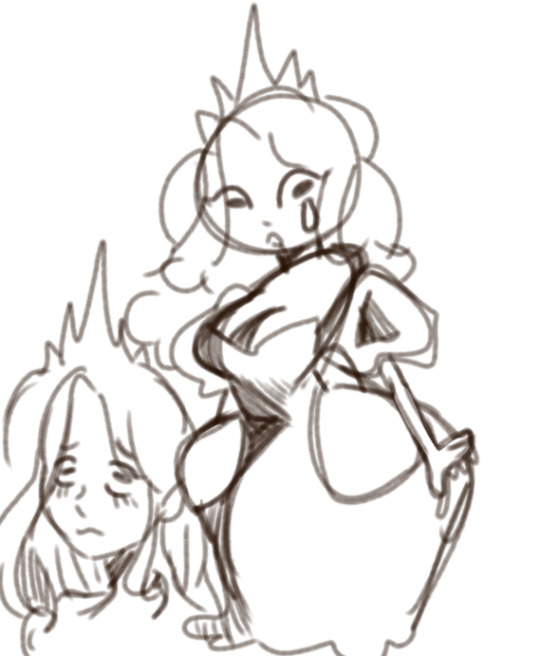
Some notes about my fan princess route, the Lure.
Basically this is an offshoot of the damsel route where you abandon damsel in the basement and just leave her thinking her beauty is just a trick. When you commit to the choice the smitten is so distraught he ends it all thus leading to chapter 3 the Lure.
The voices that join you are hero, smitten, and paranoid.
The forest is now a swamp with the distant sounds of frogs croaking and the basement is l flooded with lillypads floating about (I imagine you have to jump on them to get close to the princess). The princess rests on top a giant lillypad and begs you not to leave her again.
If you try to save her, she'll wrap in a tight embrace and you'll realize you can't get out because her hands are incredibly sticky and if you pulls away she'll rip the meat off your bones with her hands.
If you try to leave again, she'll chase you down while begging you not to leave her again until the hands get her.
"This vessel had her trust broken yet never wanted to leave your side. Terrified of being alone, and even more terrified of being abandoned. She will make for a fragile and wanting heart. Do not mourn her, she won't be afraid anymore"
119 notes
·
View notes
Note
For your aus, does the song "stayed gone" still happen?
Well, in the main version of the Devil's Bastard AU it does. That AU is mainly about toying around with a different dynamic between Alastor, Lucifer, Charlie, and sometimes Lilith, but everything else about the characters' backgrounds and relationships stays the same. So Alastor has still been missing for 7 years, and still has the same sort of rivalry with Vox.
In the Kid Alastor and Raised Together offshoots, however, his place in Hell's status quo and thus his relationship with Vox is different. In Raised Together, Alastor isn't an Overlord. He's more involved in the workings of Hell's politics and the ongoings of the Overlords than Lucifer is though, and knows some of them personally. I think he and Vox might still have struck up an odd friendship in this offshoot and still had their falling out, but since Alastor is publicly acknowledged as Lucifer's son here, Vox has to be a lot more careful about openly antagonizing him. Vox would smile and shake Raised Together Alastor's hand while quietly seething and plotting ways to wrap a chain around Alastor's throat.
In the Kid AU, no one knows that the Radio Demon and Alastor are the same person. Vox has a rivalry with the Radio Demon, but it's more of a straightforward rivalry rather than the borderline psychosexual obsession he has in canon. He doesn't know who Alastor is, and if he did he wouldn't care. So when Alastor moves into the hotel, he flies completely under the Vees' radar. In canon, Alastor never announced his return. Vox himself did that and Alastor merely responded to Vox attempting to drag his name through the mud on live television. Alastor's, 'I know it's been a while since someone with style treated Hell to a broadcast,' line makes me think that in his time since joining Charlie, he hasn't been broadcasting at all either. In other words, in the Kid Alastor AU, Vox has no idea that the Radio Demon is even back until he sees the footage of the battle against the exorcists and sees the Radio Demon's magic swirling around the battlefield. Of course, you can imagine his shock when Adam smashes through Alastor's shield to reveal a little brat standing on the roof top.
#ask#anonymous#Hazbin Hotel#the Devil's Bastard AU#Raised Together AU#Kid Alastor AU#Alastor#Vox#KA AU Vox: The Radio Demon's a ten year old brat!?#KA AU Alastor: I'm a hundred so shut the fuck up!
59 notes
·
View notes
Text
Horrite time to get cancelled...
I loved Our Skyy x Bad Buddy x A Tale of Thousand Stars from start to finish. Yes, even the third episode. In fact, especially the third episode. And that's because Aof may have a flair for the dramatic, and he and his room might sometimes write themselves a little bit into a corner, but it's always in service of a point that he feels compelled to make. Aof doesn't go in for 'right' he goes in for 'real' and it can be hard to accept sometimes the ideas he treats with optimism vs the ones he treats with realism. Aof is very deliberate and specific in the stories he wants to tell, and they're not always satisfying. And nowhere has he leaned into that dissatisfaction more than in Bad Buddy. Pat and Pran are caught in a frustrating situation, and Aof has consistently refused to shy away from that for the sake of a traditional happy ending. Aof's major thesis with these two has always been 'love, despite everything'.
The big 'everything' in the Bad Buddy story refers to the parents, but things with the parents have offshoots and consequences for how Pat and Pran's relationship functions, both in the macro sense, in the continued need to hide, and in the micro sense, in the fact that really, truly, only one of them is hiding. Because Pat? Does not give a shit about Ming. Like TRULY. We see here that Ming is not one of his considerations, and even when asked to consider him, the distance that has grown in their relationship is such that where Ming previously was all up in Pat's business, now he doesn't even look because he doesn't want to know. In a way, Ming has accepted Pat and Pran's relationship by resolutely looking away from them. He has lost face entirely and the only solution to that is to pretend it isn't happening, which suits Pat just fine.
Dissaya though...well that's different isn't it. They are really in this closet, Pat is really in this closet for the sake of Pran's relationship with his mother. Pat and Pran's relationship is inherently unbalanced, because the compromise that Pat has made, the sacrifice he has made, is something Pran can never really make up to him. As I said to the clowns: Pran could give in to Pat every day, on everything, for the rest of their lives, and those scales would still never balance out. All Pran can do is accept Pat's sacrifice for the love it is, and love Pat back as hard as he can and hope they never regret it. And so, are they really going to fight about this? Is this really going to be an issue for them? Well...no. Are they going to get into their feelings about it from time to time? Absolutely. And then they're gonna fuck their way through that, because they're them, and they decided when they got into this that it was going to be for life, and there's really nothing else to be done in this situation but get over it.
Also I consider that this particular spat that Pat and Pran are having is only notionally about their relationship, but largely about Pran coming to a resolution about how large he wants to let Dissaya loom in his life, and thus will only scratch the surface because it's the beginning of a story we won't really see that ends up with Pran in Singapore. Pran is deeply contemplating Pat's oddly piercing words about his ability to stand on his own. Because one of the reasons that Pat has to make this compromise and stay in the closet is that Pran depends, in so many ways, on his mom. Dissaya is at the centre of his life. And I think this trip, and this fight, gets Pran to start the process of moving Pat into that spot instead. In the fourth episode, him saying that Dissaya is ok with the play because she knows it's just a play... I highly doubt that, but really, what is she going to do about it at this point? What can she do? Pran's too grown to send him away, and she knows what happened last time she tried to intervene, she nearly lost her kid. She'll tell herself what she needs to, and Pran will continue to shift the balance of his priorities from her needs to Pat's. It's that thing about leaving your parents and cleaving to your partner. If Pran can get to a place where he is independent, then he can give Pat back the openness that makes him happy, and maybe that can finally bring some balance. But we know that day is far off for them, beyond even what we've seen. All Pran can give Pat now is the promise that 'I can't live without you either'.
When it comes to these two, Aof is never going to give us the ease in the heart that we crave, because they don't have that ease either. Instead, we will get snatched moments, because that's what they get. We will get uncomfortable compromises, because that's what they get. We will get occasionally hurt feelings, because that's what they get. And we will get love, despite everything, because that's what they do. Yes it's unsatisfying. But I'd argue it's meant to be. The thing is here again: are you here for a ship or a story? And if you're here for a story, are you prepared for it to be an inherently sad and frustrating one, but that still has joy threaded throughout?
Man that leads me to so many thoughts about why juxtaposing this story with Tian and Phupha's works gangbusters, but I think that's a separate post.
223 notes
·
View notes